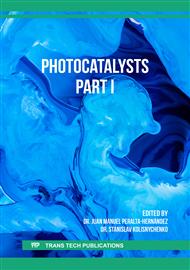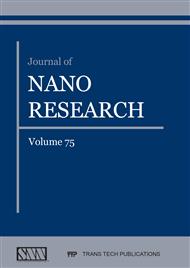[1]
A. Zafar, R. Rizvi, I. Mahmood, Biofabrication of silver nanoparticles from various plant extracts: blessing to nanotechnology, Intern. J. Environ. Anal. Chem. 99 (2019) 1434-1445.
DOI: 10.1080/03067319.2019.1622698
Google Scholar
[2]
A. Waris, M. Din, A. Ali, S. Afridi, A. Baset, A.U. Khan, M. Ali, Green fabrication of Co and Co3O4 nanoparticles and their biomedical applications: A review, Open Life Sci. 16 (2021) 14-30.
DOI: 10.1515/biol-2021-0003
Google Scholar
[3]
D. Zhang, X.-l. Ma, Y. Gu, H. Huang, G.-w. Zhang, Green Synthesis of Metallic Nanoparticles and Their Potential Applications to Treat Cancer, Front. Chem. 8 (2020) Article ID: 799.
DOI: 10.3389/fchem.2020.00799
Google Scholar
[4]
D. Garg, A. Sarkar, P. Chand, P. Bansal, D. Gola, S. Sharma, S. Khantwal, R. Mehrotra, N. Chauhan, R.K. Bharti, Synthesis of silver nanoparticles utilizing various biological systems: mechanisms and applications—a review, Prog. Biomater. 9 (2020) 81-95.
DOI: 10.1007/s40204-020-00135-2
Google Scholar
[5]
T.S. Alomar, N. AlMasoud, M.A. Awad, M.F. El-Tohamy, D.A. Soliman, An eco-friendly plant-mediated synthesis of silver nanoparticles: Characterization, pharmaceutical and biomedical applications, Mater. Chem. Phys. 249 (2020) Article ID: 123007.
DOI: 10.1016/j.matchemphys.2020.123007
Google Scholar
[6]
N. Genc, I. Yildiz, R. Chaoui, R. Erenler, C. Temiz, M. Elmastas, Biosynthesis, characterization and antioxidant activity of oleuropein-mediated silver nanoparticles, Inorg. Nano-Met. Chem. 51 (2021) 411-419.
DOI: 10.1080/24701556.2020.1792495
Google Scholar
[7]
F. Oke-Altuntas, I. Demirtas, A.R. Tufekci, S. Koldas, F. Gul, L. Behcet, H.I. Gecibesler, Inhibitory Effects of the Active Components Isolated from Satureja Boissieri Hausskn. Ex Boiss. On Human Cervical Cancer Cell Line, J. Food Biochem. 40 (2016) 499-506.
DOI: 10.1111/jfbc.12238
Google Scholar
[8]
F. Oke-Altuntas, G. Kapche, J.L.N. Ouete, I. Demirtas, M.B. Koc, B.T. Ngadjui, Bioactivity evaluation of cudraxanthone I, neocyclomorusin and (9 beta h)-3 beta-acetoxylanosta-7,24-diene isolated from Milicia excelsa Welw. C. C. Berg (Moraceae), Med. Chem. Res. 25 (2016) 2250-2257.
DOI: 10.1007/s00044-016-1670-3
Google Scholar
[9]
S. Zerrouki, S. Mezhoud, A. Sahin Yaglioglu, C. Bensouici, M. Nuri Atalar, I. Demirtas, S. Ameddah, R. Mekkiou, Antioxidant, anticancer activities, and HPLC-DAD analyses of the medicinal halophyte Limoniastrum guyonianum Dur. extracts, J. Res. Phar. 26 (2022) 598-608.
DOI: 10.29228/jrp.157
Google Scholar
[10]
G. Topçu, R. Erenler, O. Çakmak, C.B. Johansson, C. Çelik, H.-B. Chai, J.M. Pezzuto, Diterpenes from the berries of Juniperus excelsa, Phytochemistry 50 (1999) 1195-1199.
DOI: 10.1016/s0031-9422(98)00675-x
Google Scholar
[11]
F. Eser, M. Altun, I. Demirtas, L. Behcet, E. Aktas, Three new iridoids from the aerial parts of Nepeta teucriifolia Willd. and antiproliferative activities of extracts, Nat. Prod. Res. (2022) 1-10.
DOI: 10.1080/14786419.2022.2036148
Google Scholar
[12]
A.S. Yaglioglu, D.G. Gurbuz, M. Dolarslan, I. Demirtas, First determination of anticancer, cytotoxic, and in silico ADME evaluation of secondary metabolites of endemic Astragalus leucothrix Freyn & Bornm, Turk. J. Chem. 46 (2022) 169-183.
DOI: 10.3906/kim-2104-23
Google Scholar
[13]
I. Demirtas, R. Erenler, M. Elmastas, A. Goktasoglu, Studies on the antioxidant potential of flavones of Allium vineale isolated from its water-soluble fraction, Food Chem. 136 (2013) 34-40.
DOI: 10.1016/j.foodchem.2012.07.086
Google Scholar
[14]
R. Kasimogullari, H. Duran, A.S. Yaghoglu, S. Mert, I. Demirtas, Design, synthesis, characterization, and antiproliferative activity of novel pyrazole-3-carboxylic acid derivatives, Monatsh. Chem. 146 (2015) 1743-1749.
DOI: 10.1007/s00706-015-1450-7
Google Scholar
[15]
A. Güvenç, P. Houghton, H. Duman, M. Coşkun, P. Şahin, Antioxidant activity studies on selected Sideritis. species native to Turkey, Pharm. Biol. 43 (2005) 173-177.
DOI: 10.1080/13880200590919528
Google Scholar
[16]
E. Yeşilada, G. Honda, E. Sezik, M. Tabata, T. Fujita, T. Tanaka, Y. Takeda, Y. Takaishi, Traditional medicine in Turkey. V. Folk medicine in the inner Taurus Mountains, J. Ethnopharmacol. 46 (1995) 133-152.
DOI: 10.1016/0378-8741(95)01241-5
Google Scholar
[17]
C. Gabrieli, E. Kokkalou, A glucosylated acylflavone from Sideritis raeseri, Phytochemistry 29 (1990) 681-683.
DOI: 10.1016/0031-9422(90)85149-a
Google Scholar
[18]
G. Topcu, A.C. Goren, T. Kilic, Y.K. Yildiz, G. Tumen, Diterpenes from Sideritis trojana, Nat. Prod. Lett. 16 (2002) 33-37.
Google Scholar
[19]
N. Aligiannis, E. Kalpoutzakis, I. Chinou, S. Mitakou, E. Gikas, A. Tsarbopoulos, Composition and antimicrobial activity of the essential oils of five taxa of Sideritis from Greece, J. Agr. Food Chem. 49 (2001) 811-815.
DOI: 10.1021/jf001018w
Google Scholar
[20]
N. Kirimer, K. Baser, B. Demirci, H. Duman, Essential oils of Sideritis species of Turkey belonging to the section Empedoclia, Chem. Nat. Compd. 40 (2004) 19-23.
DOI: 10.1023/b:conc.0000025458.00475.cf
Google Scholar
[21]
A. Basile, F. Senatore, R. Gargano, S. Sorbo, M. Del Pezzo, A. Lavitola, A. Ritieni, M. Bruno, D. Spatuzzi, D. Rigano, Antibacterial and antioxidant activities in Sideritis italica (Miller) Greuter et Burdet essential oils, J. Ethnopharmacol. 107 (2006) 240-248.
DOI: 10.1016/j.jep.2006.03.019
Google Scholar
[22]
N. Ezer, R. Vila, S. Cañigueral, T. Adzet, Essential oil composition of four Turkish species of Sideritis, Phytochemistry 41 (1996) 203-205.
DOI: 10.1016/0031-9422(95)00601-x
Google Scholar
[23]
E. González-Burgos, M. Carretero, M. Gómez-Serranillos, Sideritis spp.: uses, chemical composition and pharmacological activities—a review, J. Ethnopharmacol. 135 (2011) 209-225.
DOI: 10.1016/j.jep.2011.03.014
Google Scholar
[24]
B.M. Fraga, Phytochemistry and chemotaxonomy of Sideritis species from the Mediterranean region, Phytochemistry 76 (2012) 7-24.
DOI: 10.1016/j.phytochem.2012.01.018
Google Scholar
[25]
F. Piozzi, M. Bruno, S. Rosselli, A. Maggio, The diterpenoids from the genus Sideritis, Stud. Nat. Prod. Chem. 33 (2006) 493-540.
DOI: 10.1016/s1572-5995(06)80033-5
Google Scholar
[26]
K. Bekhouche, T. Ozen, S. Boussaha, S. Koldas, S. Yenigun, S. Lassed, I. Demirtas, F. Benayache, S. Benayache, D. Zama, Anti-oxidant, DNA-damage protection and anti-cancer properties of n-butanol extract of the endemic Perralderia coronopifolia, Bangladesh J. Pharmacol. 13 (2018) 82-89.
DOI: 10.3329/bjp.v13i1.34255
Google Scholar
[27]
M.A. Demirci, Y. Ipek, F. Gul, T. Ozen, I. Demirtas, Extraction, isolation of heat-resistance phenolic compounds, antioxidant properties, characterization and purification of 5-hydroxymaltol from Turkish apple pulps, Food Chem. 269 (2018) 111-117.
DOI: 10.1016/j.foodchem.2018.06.147
Google Scholar
[28]
R. Erenler, B. Meral, O. Sen, M. Elmastas, A. Aydin, O. Eminagaoglu, G. Topcu, Bioassay-guided isolation, identification of compounds from Origanum rotundifolium and investigation of their antiproliferative and antioxidant activities, Pharm. Biol. 55 (2017) 1646-1653.
DOI: 10.1080/13880209.2017.1310906
Google Scholar
[29]
F. Oke-Altuntas, M. Altun, I. Demirtas, L. Behcet, A Comparative Study on Fatty Acid Compositions, Total Phenolic Contents, and Antioxidant Potentials of Various Extracts from Different Parts of Euphorbia chamaesyce L, Gazi Univ.J. Sci. 31 (2018) 677-685.
Google Scholar
[30]
M. Vanaja, K. Paulkumar, M. Baburaja, S. Rajeshkumar, G. Gnanajobitha, C. Malarkodi, M. Sivakavinesan, G. Annadurai, Degradation of methylene blue using biologically synthesized silver nanoparticles, Bioinorg. Chem. Appl. 2014 (2014) Article ID 742346.
DOI: 10.1155/2014/742346
Google Scholar
[31]
N. Genc, M. Elmastas, I. Telci, R. Erenler, Quantitative analysis of phenolic compounds of commercial basil cultivars (Ocimum basilicum L.) by LC-TOF-MS and their antioxidant effects, Int. J. Chem. Technol. 4 (2020) 179-184.
DOI: 10.32571/ijct.795629
Google Scholar
[32]
P. Koysu, N. Genc, M. Elmastas, H. Aksit, R. Erenler, Isolation, identification of secondary metabolites from Salvia absconditiflora and evaluation of their antioxidative properties, Nat. Prod. Res. 33 (2019) 3592-3595.
DOI: 10.1080/14786419.2018.1488700
Google Scholar
[33]
N. Genç, İ. Yıldız, T. Karan, Ö. Eminağaoğlu, R. Erenler, Antioxidant activity and total phenolic contents of Galanthus woronowii (Amaryllidaceae), Turk. J. Biodiv. 2 (2019) 1-5.
DOI: 10.38059/biodiversity.515111
Google Scholar
[34]
B. Janeska, M. Stefova, K. Alipieva, Assay of flavonoid aglycones from species of the genus Sideritis (Lamiaceae) from Macedonia with HPLC UV DAD, Acta Pharm. 57 (2007) 371-377.
DOI: 10.2478/v10007-007-0030-8
Google Scholar
[35]
E.N. Gecer, R. Erenler, C. Temiz, N. Genc, I. Yildiz, Green synthesis of silver nanoparticles from Echinacea purpurea (L.) Moench with antioxidant profile, Particul. Sci. Technol. 40 (2021) 50-57.
DOI: 10.1080/02726351.2021.1904309
Google Scholar
[36]
H.D. Beyene, A.A. Werkneh, H.K. Bezabh, T.G. Ambaye, Synthesis paradigm and applications of silver nanoparticles (AgNPs), a review, Sust. Mat. Technol. 13 (2017) 18-23.
DOI: 10.1016/j.susmat.2017.08.001
Google Scholar
[37]
M. Shao, A. Peles, K. Shoemaker, Electrocatalysis on platinum nanoparticles: particle size effect on oxygen reduction reaction activity, Nano Lett. 11 (2011) 3714-3719.
DOI: 10.1021/nl2017459
Google Scholar
[38]
M.I. Al-Zaban, M.A. Mahmoud, M.A. AlHarbi, Catalytic degradation of methylene blue using silver nanoparticles synthesized by honey, Saudi J. Biol. Sci. 28 (2021) 2007-2013.
DOI: 10.1016/j.sjbs.2021.01.003
Google Scholar
[39]
V. Suvith, D. Philip, Catalytic degradation of methylene blue using biosynthesized gold and silver nanoparticles, Spectrochim. Acta A Mol. Biomol. Spectrosc. 118 (2014) 526-532.
DOI: 10.1016/j.saa.2013.09.016
Google Scholar
[40]
B. Dag, Green synthesis, characterization, and antioxidant activity of silver nanoparticles using Stachys annua L. subsp. annua var. annua, Particul. Sci. Technol. 40 (2022) 512-520.
DOI: 10.1080/02726351.2021.1966689
Google Scholar
[41]
R. Erenler, B. Dag, Biosynthesis of silver nanoparticles using Origanum majorana L. and evaluation of their antioxidant activity, Inorg. Nano-Met. Chem. 52 (2022) 485-492.
Google Scholar
[42]
R. Erenler, E.N. Geçer, N. Genç, D. Yanar, Antioxidant activity of silver nanoparticles synthesized from Tagetes erecta L. leaves, Int. J. Chem. Technol. 5 (2021) 141-146.
DOI: 10.32571/ijct.1005275
Google Scholar
[43]
E.N. Gecer, Green Synthesis of Silver Nanoparticles from Salvia aethiopis L. and Their Antioxidant Activity, J. Inorg. Organomet. Polym. Mater. 31 (2021) 4402-4409.
DOI: 10.1007/s10904-021-02057-3
Google Scholar
[44]
N. Genc, Biosynthesis of silver nanoparticles using Origanum onites extract and investigation of their antioxidant activity, Particul. Sci. Technol. 39 (2021) 562-568.
DOI: 10.1080/02726351.2020.1786868
Google Scholar
[45]
A.K. Mittal, A. Kaler, U.C. Banerjee, Free Radical Scavenging and Antioxidant Activity of Silver Nanoparticles Synthesized from Flower Extract of Rhododendron dauricum, Nano Biomed. Eng. 4 (2012) 118-124.
DOI: 10.5101/nbe.v4i3.p118-124
Google Scholar
[46]
A. Wang, Y. Wang, C. Sun, C. Wang, B. Cui, X. Zhao, Z. Zeng, J. Yao, D. Yang, G. Liu, Fabrication, characterization, and biological activity of avermectin nano-delivery systems with different particle sizes, Nano. Res. Lett. 13 (2018) 1-7.
DOI: 10.1186/s11671-017-2405-1
Google Scholar
[47]
C.-N. Lok, C.-M. Ho, R. Chen, Q.-Y. He, W.-Y. Yu, H. Sun, P.K.-H. Tam, J.-F. Chiu, C.-M. Che, Silver nanoparticles: partial oxidation and antibacterial activities, J. Biol. Inorg. Chem. 12 (2007) 527-534.
DOI: 10.1007/s00775-007-0208-z
Google Scholar



